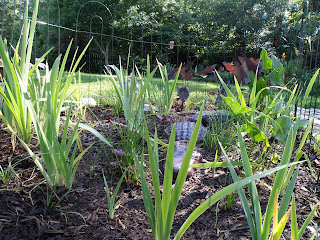I decided to make a small rain garden in a spot where one of our rain barrels overflows.

You might wonder: What is a Rain Garden? In simple terms it is a shallow depression that is planted with deep-rooted native plants and grasses. The garden should be positioned near a runoff source like a downspout, driveway or sump pump to capture rainwater runoff and stop the water from reaching the sewer system.

Your next question might be: Why plant a rain garden? Backyard rain gardens are a fun and inexpensive way to improve water quality and enhance the beauty of your yard. When placed between stormwater runoff sources (roofs, driveways, parking lots) and runoff destinations (storm drains, streets, streams) a rain garden captures runoff from your driveway or roof and allows it to soak into the ground, rather than running across roads, collecting pollutants, and delivering them to a stream. Plants and soil will work together to absorb and filter pollutants and return cleaner water through the ground to nearby streams.

You may wonder: What about mosquitos? The rain garden fills with a few inches of water after a storm, and the water slowly filters into the ground. Because water is only in the rain garden for a day or two, it doesn’t become a breeding ground for mosquitos?

My garden was a small experiment just to see how it would handle the overflow from my rain barrel. I wish I had learned about this garden idea before I originally laid out plans for my backyard landscape (Yes I did initially have a landscape plan and mostly followed it!) so I could have incorporated it into plan from the beginning. My little creation may not be a classic rain garden but it seems to be holding up to our rain.

My biggest problem was keeping the dogs out of it while my plants are getting started. Annabelle liked to eat the tops off plants and thought it was a nice cool spot to take a nap and Maggie just liked to walk through the middle right over the plants. So I put up a small portable fence leaving a small cut through for the dogs on one end of the garden. This was one of their orginal pathways into the yard from the back porch.

Keep in mind that Rain gardens work best when constructed in well-drained or sandy soils, but they can also be installed on sites with less permeable soils such as clays but may need some additional work.

You can easily find books and information on rain gardens. Some you may find helpful are from the Clemson HGIC http://media.clemson.edu/public/restoration/carolina%20clear/toolbox/publication_raingardenmanual_022709.pdf or your local area extension office.
Another good source Rain Gardening.org https://www.raingardens.org/index.php?gclid=COD0iJj4yrcCFQ3l7AodmhsAvw

Hope this gives you an idea for your own yard.
No comments:
Post a Comment